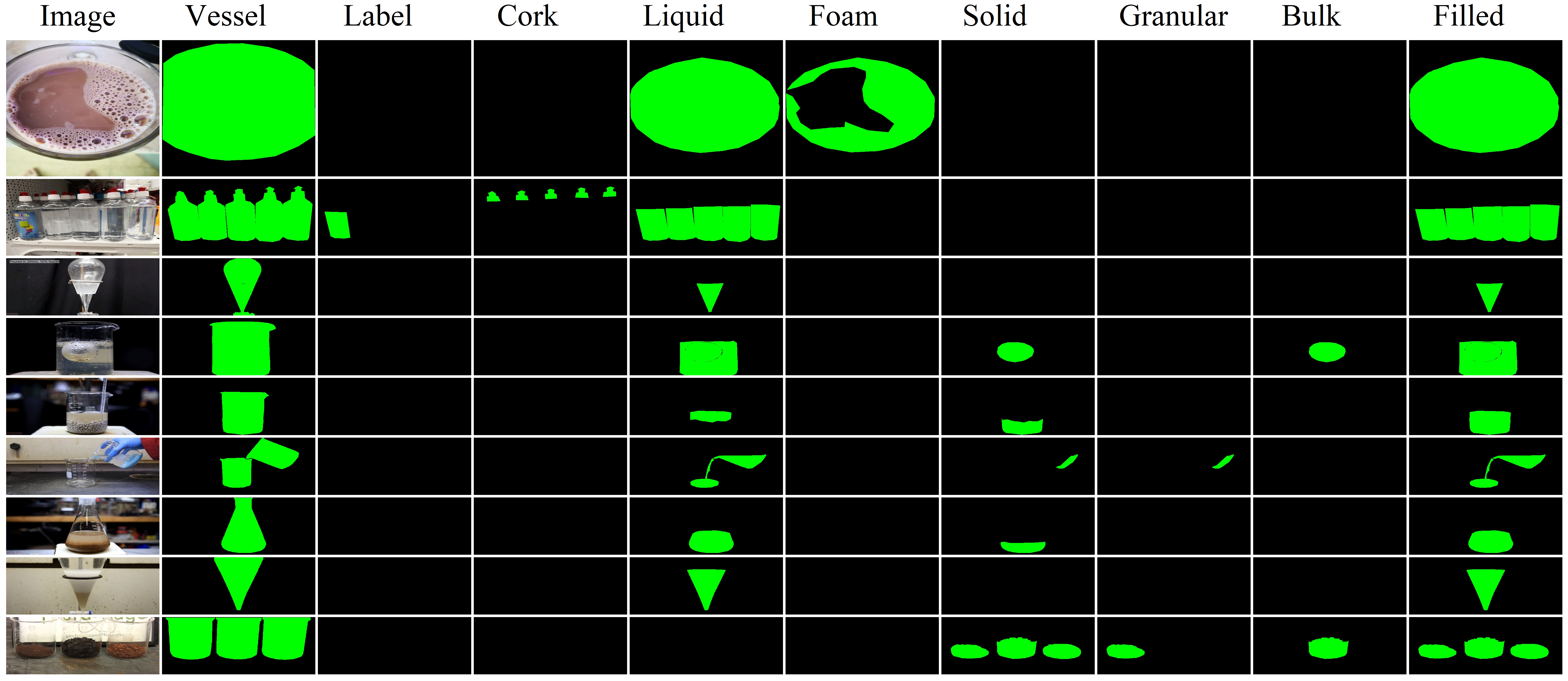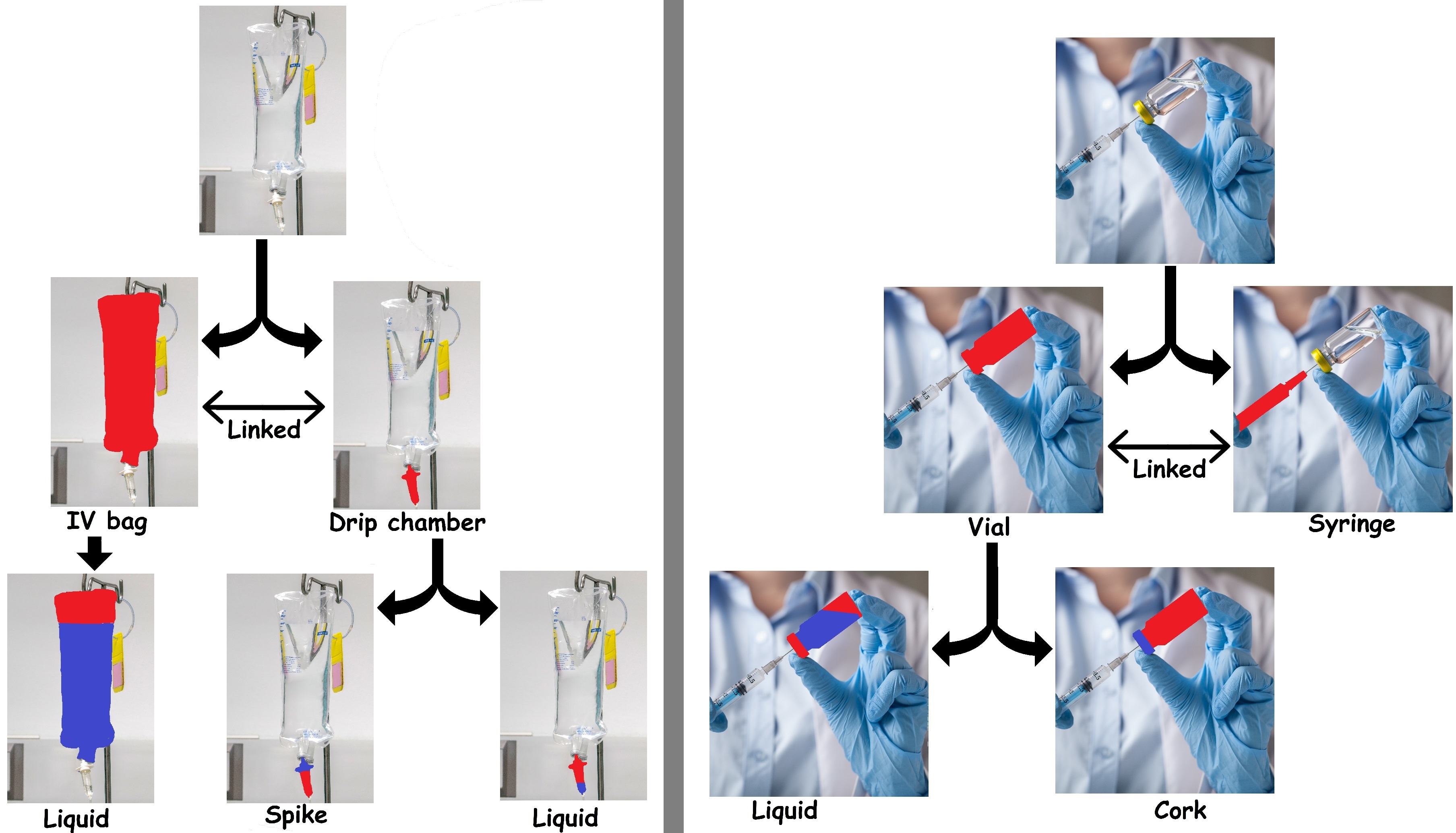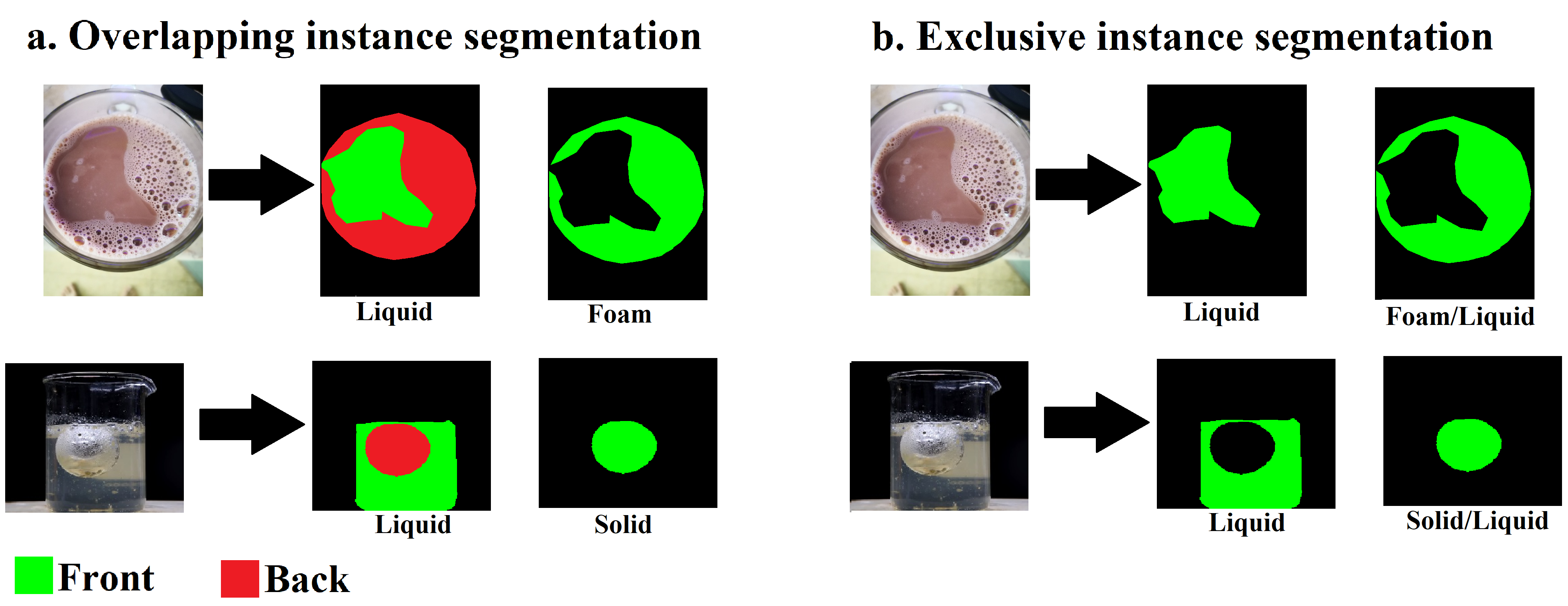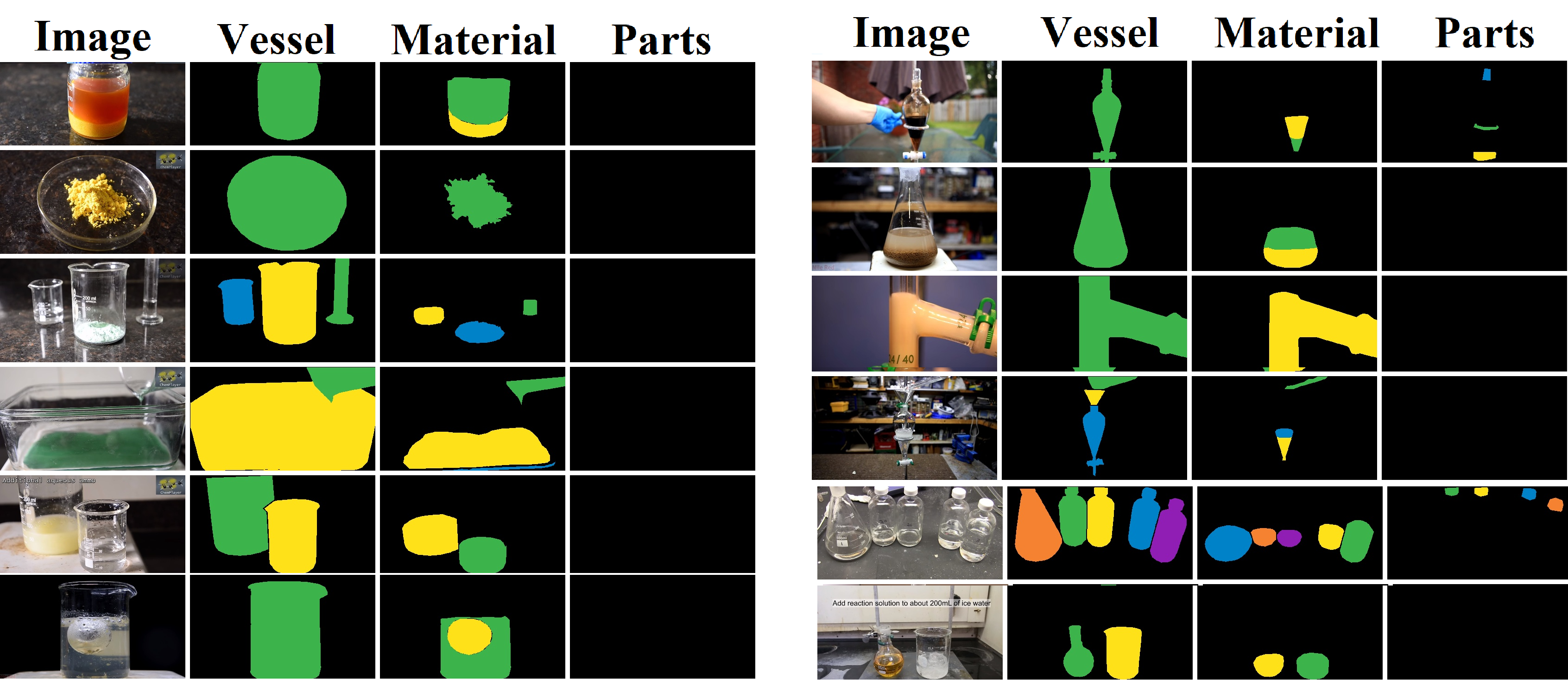The Vector-LabPics dataset focus on visual understanding for materials, vessels, and experiments in the chemistry lab, medical lab, hospitals, and any field where liquid, solids and other materials are handled in containers.
The Vector-LabPics dataset consists of 7900 images of materials in various of phases and proccess within mostly transparent vessels in chemistry labs, medical labs and hospitals and other environments.
The images are annotated for both the vessels and the individual material phases inside them, and each instance is assigned one or more classes (liquid, solid, foam, suspension, powder, gel, granular, vapor) .
The fill level, labels, corks, and other parts of the vessel are also annotated.
The material classes cover the main states of matter, including liquids, solids, vapors, foams, gels, and subcategories like powder, granular, and suspension.
Relationships between materials such as which material immersed inside other material are annotated.
The vessel class cover glassware, labware plates, bottles, and any other type of vessel that are used to contain or carry materials.
The type of vessel (e.g., syringe, tube, cup, infusion bottle/bag), and the properties of the vessel (transparent, opaque) are annotated.
In addition, vessel parts such as corks, labels, spikes, and valves are annotated. Relations and hierarchies between vessels and materials are also annotated, such as which vessel contains which material or which vessels are linked or contain each other.
The images were collected from various contributors and cover most aspects of chemistry lab works as well as a variety of other fields where materials are handled in container vessels.
Documents specifying annotation formats are available inside the dataset file. Version 1 contain 2200 images with simple instance and semantic annotations, and is relatively simple to use, it is described in the paper
Instance Segmentation
 Semantic Segmentation
Semantic Segmentation
 Relations prediction (Image taken from ShutterStock with premission)
Relations prediction (Image taken from ShutterStock with premission)
Annotation Details
The annotation was done manually using the
VGG image annotator (VIA).
Each individual vessel and material phase were annotated, as were the labels, corks, and other parts of the vessels (valves, etc..).
Each instance segment received one or more classes. The dataset has two representations. The non-exclusive representation is based on overlapping instances. In this mode, the different segments can overlap;
for example, when a solid phase is immersed in a liquid phase, the solid and liquid phases will overlap. In a case of overlap, a priority (front/back) was added to each segment in the overlap region.
The dataset also contains a simple version with non-overlapping instances. In this case, each pixel can correspond to only one vessel instance and one material instance.
If there is overlap, the front instance with higher priority is used, and the back instance is ignored, in the overlapping region. In addition, the pixel can be assigned one label/part instance.
Altogether, the simple representation has three channels: (i) the vessel instance; (ii) the material instance; (iii) the label/cork/vessel part instance. Instances from the same channel cannot overlap; this means that two material instances may not overlap, but that the material and vessel instances may overlap.
The dataset also contains semantic representation in which each pixel is assigned several classes but no instance. More accurately, each class has a binary map containing all the pixels belonging to this class. This semantic representation is not instance-aware and does not allow us to separate different instances of the same class, such as adjacent vessels or phase-separating liquids.

Categories
Materials Classes: Liquid, Foam, Suspension, Solid, Powder, Urine, Blood, Gel, Granular, SolidLargChunk, Vapor, Other Material, Filled
Material Properties: Material On vessel Surface, Material Scattered, Material Immersed Inside other material
Vessel/Container/Plates Classes: Vessel, Syringe, Pipette, Tube, IVBag, DripChamber, IVBottle, Beaker, RoundFlask, Cylinder, SeparatoryFunnel, Funnel, Burete, ChromatographyColumn, Condenser, Bottle, Jar, Connector, Flask, Cup, Bowl, Erlenmeyer, Vial, Dish, HeatingVessel, Tube
Vessel Properties: Transparent, SemiTrans, Opaque, DisturbeView, VesselInsideVessel
Vessels Parts Classes:Cork, Label, Part, Spike, Valve, Magnetic Stirrer, Thermometer, Spatula, Holder, Filter, Pipe/Tube/Straw
Contact
The LabPics Dataset was created by
the Matter Lab, Alan Aspuru group, feel free to contact us using this
email.
Contribute Images
Anyone who have images relevant to the dataset is encouraged to contact us by
email.
Copyright
Copyright for all images belongs to their contributers (the image source is the source.txt next to the image).
Copyright for images with file name start with IMG_ belong to the Alan-Aspuru group and are licensed under a
Attribution-NonCommercial-NoDerivatives 4.0 International (CC BY-NC-ND 4.0).
Copyright for annotation belong to the Alan-Aspuru group and are licensed under a
Attribution-NonCommercial-NoDerivatives 4.0 International (CC BY-NC-ND 4.0).
OrganicElectronic (Instogram) pictures are taken from @organicelectronic, which is run by Nuray Altinolcek, a PhD student in Prof. Dr Mustafa Tavasli’s Research Group at Uludag University.
Images from C&EN's Chemistry in Pictures (cen.chempics.org) used here with permission from C&EN and ACS. All rights reserved. Please contact
cenchempics@acs.org to inquire about republishing.
Paper
More detail on the can be found in:
"Computer vision for recognition of materials and vessels in chemistry lab settings and the Vector-LabPics dataset." (2020).
Image source and copyright
Creating this dataset was possible thanks to community of chemists and who
take high-quality photos of their experiments. Most of the
images of this dataset were shared by these sources. Copyright for
all images belongs to their contributors. The dataset is shared for
academic purposes only. For any other use of the images, inquire with
the image source. The source of every image is mention in the
source.txt file located next to the image file. Specific copyright
for each image also appears in the same file. If no copyright is
mentioned, contact the image source for inquiries.
The main sources of images used for the dataset:
Nessa
Carson (@SuperScienceGrl Twitter),
Chemical
and Engineering Science, Chemistry in Pictures
YouTube
NileRed,
NurdRage,
ChemPlayer,
NileRed,
DougsLab,
Koen2All
Instagram
chemistrylover_(Joana
Kulizic),
Chemistry.shz
(Dr.Shakerizadeh-shirazi),
MinistryOfChemistry,
ifhoodscouldtalk,
synthesis.diaries,
ChemistryAndMe,
organicelectronic
(Nuray Altinolcek),
chembysarah
Tumblr
labphoto,
hood32,
itslikemagicbutbetter,
focus-on-pharmacy,nomadpostgrad,Yourfunwithchem
Tumblr
Yourfunwithchem:
https://www.tumblr.com/blog/view/yourfunwithchem
Itslikemagicbutbetter:
https://itslikemagicbutbetter.tumblr.com/
Focus-on-pharmacy:
https://focus-on-pharmacy.tumblr.com/
Hood32:
https://hood32.tumblr.com/
nomadpostgrad:https://www.tumblr.com/blog/view/nomadpostgrad
LabPhoto: https://labphoto.tumblr.com/
Academic
Labs
Joshua
Schrier Lab,Hein
Lab (Tara Zepel), Burke
Lab (Angello Nicholas)
Lee
Cronin Lab (Amir Khan),Matter
Lab, Alan Aspuru-Guzik Group (Andrés Aguilar Granda,Haoping
Xu)
Permissions
Images
from C&EN's Chemistry in Pictures (cen.chempics.org)
used here with permission from C&EN and ACS. All rights reserved.
Please contact cenchempics@acs.org to inquire about republishing.
labphoto:
images are licensed under a Creative Commons
Attribution-NonCommercial-NoDerivatives 4.0 International License
Images
takend by theAlan
Aspuru-Guzik Group
licensed under a Attribution-NonCommercial-NoDerivatives 4.0
International (CC BY-NC-ND 4.0).
OrganicElectronic
(Instogram) pictures are taken from @organicelectronic,
which is run by Nuray Altinolcek, a PhD student in Prof. Dr Mustafa
Tavasli’s Research Group at Uludag University.
For
all other images, contact the image source for permission.
General Chemistry Lab UfT, Collected by
cameras installed in University of tronto undegradduate chemistry
labs (with students and faculty consent) camera installed by Haoping
Xu





 Semantic Segmentation
Semantic Segmentation
 Relations prediction (Image taken from ShutterStock with premission)
Relations prediction (Image taken from ShutterStock with premission)
